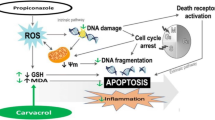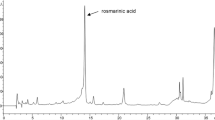Abstract
Patulin (PAT) is a mycotoxin mainly produced by Aspergillus, Penicillium, and Bissochlamys. Given the high risk associated with this mycotoxin, its potential effects have been investigated by many studies. It is known to be teratogenic, mutagenic, and genotoxic, and it has been shown to induce damages in several organs in experimental animals. Our aim was to investigate the preventive effect against PAT-induced apoptosis in vivo using natural carotenoid, Crocin (CRO). Mice were divided into six groups: a control group, a “PAT alone” group, a “CRO alone” group, and a “PAT plus CRO” groups (pre-treatment conditions). Our results showed that CRO restored the normal levels of biochemical parameters in the liver and kidney. The analysis of the protein expression in these organs revealed that PAT-induced toxicity promotes the induction of apoptosis via the increase in P53, Bax, and cytochrome C and the decrease in Bcl2 expressions. We also found that PAT triggered caspase 3 activation and DNA fragmentation. However, pre-treatment with CRO demonstrated a reduction in the induction of apoptosis via the regulation of all tested biomarkers demonstrating that CRO is effective in the protection against PAT hazards. This could be relevant, particularly with the emergent demand for natural products which may counteract the detrimental toxic effects and therefore prevents multiple human diseases.
Access this article
We’re sorry, something doesn't seem to be working properly.
Please try refreshing the page. If that doesn't work, please contact support so we can address the problem.



Similar content being viewed by others
Abbreviations
- PAT:
-
Patulin
- CRO:
-
Crocin
- AST:
-
Aspartate aminotransferase
- ALT:
-
Alanine aminotransferase
- GGT:
-
Gamma glutamyl transferase
- T-BIL:
-
Total bilirubin
- TGL:
-
Triglycerides
- CREA:
-
Creatinin
- AU:
-
Ammonuria
- T-CHOL:
-
Total cholesterol
- LDH:
-
Lactate dehydrogenase
- ALP:
-
Alkaline phosphatase
References
Alavizadeh SH, Hosseinzadeh H (2014) Bioactivity assessment and toxicity of crocin: a comprehensive review. Food Chem Toxicol 64:65–80
Alves I, Oliveira NG, Laires A, Rodrigues AS, Rueff J (2000) Induction of micronuclei and chromosomal aberrations by the mycotoxin patulin in mammalian cells: role of ascorbic acid as a modulator of patulin clastogenicity. Mutagenesis 15:229–234
Ayed-Boussema I, Abassi H, Bouaziz C, Ben Hlima W, Ayed Y, Bacha H (2013) Antioxidative and antigenotoxic effect of vitamin e against patulin cytotoxicity and genotoxicity in HepG2 cells. Environ Toxicol 28:299–306
Baert K, Devlieghere F, Flyps H, Oosterlinck M, Ahmed MM, Rajković A, Verlinden B, Nicolaï B, Debevere J, De Meulenaer B (2007) Influence of storage conditions of apples on growth and patulin production by Penicillium expansum. Inter J Food Microb 119:170–181
Boussabbeh M, Ben Salem I, Prola A, Guilbert A, Bacha H, Abid-Essefi S, Lemaire C (2015a) Patulin induces apoptosis through ROS-mediated endoplasmic reticulum stress pathway. Toxicol Sci 144(2):328–337
Boussabbeh M, Prola A, Ben Salem I, Guilbert A, Bacha H, Lemaire C, Abis-Essefi S. (2015b). Crocin and quercetin prevent PAT-induced apoptosis in mammalian cells: involvement of ROS-mediated ER stress pathway. Environ Toxicol. Aug 27. doi: 10.1002/tox.22185.
Boussabbeh M, Ben Salem I, Belguesmi F, Bacha H, Abid-Essefi S. (2015c). Tissue oxidative stress induced by patulin and protective effect of crocin. Neurotoxicology. doi: 10.1016/j.neuro.2015.11.005
Boussabbeh M, Ben Salem I, Neffati F, Najjar MF, Bacha H, Abid-Essefi S. (2015d) Crocin prevents patulin-induced acute toxicity in cardiac tissues via the regulation of oxidative damage and apoptosis. J Biochem Mol Toxicol. Jun 11. doi: 10.1002/jbt.21718.
Bradford MM (1976) A rapid and sensitive method for the quantification of microgram quantities of protein utilizing the principle of protein-dye binding. Anal Biochem 72:248–254
Burlinson B, Tice RR, Speit G, Agurell E, Brendler-Schwaab SY, Collins AR, Escobar P, Honma M, Kumaravel TS, Nakajima M, Sasaki YF, Thybaud V, Uno Y, Vasquez M, Hartmann A (2007) Fourth International Workgroup on Genotoxicity testing: results of the in vivo comet assay workgroup. Mutat Res 627:31–35
Ciegler A, Becwith AC, Jackson LK (1976) Teratogenicity of patulin and patulin adducts formed with cysteine. Appl Environ Microbiol 31:664–667
Collins AR, Dusinska M, Gedik CM, Stetina R (1996) Oxidative damage to DNA: do we have a reliable biomarker? Environ Health Perspect 104:465–9
De Melo FT, De Oliveira IM, Greggio S, Costa Dacosta J, Guecheva TN, Saffi J, Pêgas Henriques JA, Rosa RM (2012). DNA damage in organs of mice treated acutely with patulin, a known mycotoxin.
Donmez-Altuntas H, Gokalp-Yildiz P, Bitgen N, Hamurcu Z (2013) Evaluation of genotoxicity, cytotoxicity and cytostasis in human lymphocytes exposed to patulin by using the cytokinesis-block micronucleus cytome (CBMN cyt) assay. Mycotoxin Res 29:63–70
EL-Maraghy SA, Rizk SM, El-Sawalhi MM (2009) Hepatoprotective potential of crocin and curcumin against iron overload-induced biochemical alterations in rat. Afr J Biochem Res 3:215–221
Escoula L, Thomsen M, Bourdiol D, Pipy B, Peuriere S, Roubinet F (1988) Patulin immunotoxicology: effect on phagocyte activation and the cellular and humoral immune system of mice and rabbits. Int J Immunopharmacol 10:983–989
Ferrer E, Juan-Garcia A, Font G, Ruiz MJ (2009) Reactive oxygen species induced by beauvericin, patulin and zearalenone in CHO-K1 cells. Toxicology In Vitro 23:1504–1509
Geromichalos GD, Lamari FN, Papandreou MA, Trafalis DT, Margarity M, Papageorgiou A, Sinakos Z (2012) Saffron as a source of novel acetylcholinesterase inhibitors: molecular docking and in vitro enzymatic studies. J Agric Food Chem 60:6131–6138
Glaser N, Stopper H (2012) Patulin: mechanism of genotoxicity. Food Chem Toxicol 50:1796–1801
Hariri AT, Moallem SA, Mahmoudi M, Memar B, Hosseinzadeh H (2010) Subacute effects of diazinon on biochemical indices and specific biomarkers in rats: protective effects of crocin and safranal. Food Chem Toxicol 48:2803–2808
Hayes AW, Phillips TD, Williams WL, Ciegler A (1979) Acute toxicity of patuline in mice and rats. Toxicology 13:91–100
He SY, Qian ZY, Tang FT, Wen N, Xu GL, Sheng L (2005) Effect of crocin on experimental atherosclerosis in quails and its mechanisms. Life Sci 77:907–921
Heussner AH, Dietrich DR, O’Brien E (2006) In vitro investigation of individual and combined cytotoxic effects of ochratoxin A and other selected mycotoxins on renal cells. Toxicol In Vitro 20:332–41
Hosseinzadeh H, Ziaee T, Sadeghi A (2008a) The effect of saffron, Crocus Sativus stigma, extract and its constituents, safranal and crocin on sexual behaviors in normal male rats. Phytomedicine 15:491–495
Hosseinzadeh H, Abootorabi A, Sadeghnia AH (2008b) Protective effect of Crocus sativus stigma extract and crocin (trans-crocin 4) on methyl methanesulfonate induced DNA damage in mice organs. DNA Cell Biol 27:657–664
International Agency for Research on Cancer. (1968). Some naturally occurring and synthetic food components, furocoumarins and ultraviolet radiation. WHO. Available at: http://monographs.iarc.fr/ENG/Monographs/vol1-42/mono40.pdf
Kianbakht S, Mozaffari K (2009) Effects of saffron and its active constituents, crocin and safranal, on prevention of indomethacin induced gastric ulcers in diabetic and nondiabetic rats. J Med Plants 8:30–38
Kwon O, Soung NK, Thimmegowda NR, Jeong SJ, Jang JH, Moon DO, Chung JK, Lee KS, Kwon YT, Erikson RL, Ahn JS, Kim BY (2012) Patulin induces colorectal cancer cells apoptosis through EGR-1 dependent ATF3 up-regulation. Cell Signal 24:943–950
Liu BH, Yu FY, Wu TS, Li SY, Su MC, Wang MC, Shih SM (2003) Evaluation of genotoxic risk and oxidative DNA damage in mammalian cells exposed to mycotoxins, patulin and citrinin. Toxicol Appl Pharmacol 191:255–263
Mahfoud R, Maresca M, Garmy N, Fantini J (2002) The mycotoxin patulin alters the barrier function of the intestinal epithelium: mechanism of action of the toxin and protective effects of glutathione. Toxicol Appl Pharmacol 181:209–18
Mori H, Kawai K, Ohbayashi F, Kuniyasu T, Yamazaki M, Hamasaki T, Williams GM (1984) Genotoxicity of a variety of mycotoxins in the hepatocyte primary culture/DNA repair test using rat and mouse hepatocytes. Cancer Res 44:2918–2923
Naghizadeh B, Boroushaki M, Vahdati MN, Mansouri M (2008) Protective effects of crocin against cisplatin-induced acute renal failure and oxidative stress in rats, Iran. Biomed J 12:93
Osswald H, Frank HK, Komitowski D, Winter H (1978) Long term testing of patulin administer orally to Sprague-Dawley rats and Swiss mice. Food Cosmetic Toxicol 16:243–247
Pfeiffer E, Gross K, Metzler M (1998) Aneuploidogenic and clastogenic potential of the mycotoxins citrinin and patulin. Carcinogenesis 19:1313–1318
Picada JN, Flores DG, Zettler CG, Marroni NP, Roesler R, Henriques JAP (2003) DNA damage in brain cells of mice treated with an oxidized form of apomorphine. Brain Res Mol Brain Res 114:80–85
Razavi BM, Hosseinzadeh H, Movassaghi R, Imenshahidi M, Abnous K (2013) Protective effect of crocin on diazinon induced cardiotoxicity in rats in subchronic exposure. Chemico-Biological Interactions 203:547–555
Riley RT, Showker JL (1991) The mechanism of patulin’s cytotoxicity and the antioxidant activity of indole tetramic acids. Tox Appl Pharm 109:108–126
Rios JL, Recio MC, Giner RM, Manez S (1996) An update review of saffron and its active constituents. Phytother Res 10(3):189–193
Rjiba-Touati K, Ayed-Boussema I, Belarbia A, Azzebi A, Achour A, Bacha H (2013) Protective effect of recombinant human erythropoeitin against cisplatin cytotoxicity and genotoxicity in cultured Vero cells. Exp Toxicol Pathol 65(1–2):181–187
Roll R, Matthiaschk G, Korte A (1990) Embryotoxicity and mutagenicity of mycotoxins. J Environ Pathol Toxicol Oncol 10:1–7
Schumacher DM, Metzler M, Lehmann L (2005) Mutagenicity of the mycotoxin patulin in cultured Chinese hamster V79 cells, and its modulation by intracellular glutathione. Arch Toxicol 79:110–121
Scorrano L, Korsmeyer S (2003) Mechanisms of cytochrome c release by proapoptotic BCL-2 family members. Biophys Res Commun 304:437–444
Song E, Xia X, Su C, Dong W, Xian Y, Wang W, Song Y (2014a) Hepatotoxicity and genotoxicity of patulin in mice, and its modulation by green tea polyphenols administration. Food Chem Toxicol 71:122–127
Song E, Su C, Fu J, Xia X, Yang S, Xiao C, Lu C, Chen H, Sun Z, Wu S, Song Y (2014b) Selenium supplementation shows protective effects against patulin-induced brain damage in mice via increases in GSH-related enzyme activity and expression. Life Sci 109:37–43
Speijers GJ, Franken MA, van Leeuwen FX (1988) Subacute toxicity study of patulin in the rat: effects on the kidney and the gastro-intestinal tract. Food Chem Toxicol 26:23–30
Tice RR, Agurell E, Anderson D, Burlinson B, Hartmann A, Kobayashi Y (2000) Single cell gel/comet assay: guidelines for in vitro and in vivo genetic toxicology testing. Environ Mol Mutagen 35:206–221
Wichmann G, Herbarth O, Lehmann I (2002) The mycotoxins citrinin, gliotoxin, and patuline affect interferon-gamma rather than interleukin-4 production in human blood cells. Environ Toxicol 17:211–8
Wu T, Liao Y, Yu F, Chang C, Liu B (2008) Mechanism of patulin-induced apoptosis in human leukemia cells (HL-60). Toxicol Lett 183(1):105–111
Zhang B, Peng X, Li G, Xu Y, Xia X, Wang Q (2015) Oxidative stress is involved in patulin induced apoptosis in HEK293 Cells. Toxicon 94:1–7
Zhou S, Jiang L, Geng C, Cao J, Zhong L (2009) Patulin-induced genotoxicity and modulation of glutathione in HepG2 cells. Toxicon 53:584–586
Zhou S, Jiang L, Geng C, Cao J, Zhong L (2010) Patulin-induced oxidative DNA damage and p53 modulation in HepG2 cells. Toxicon 55:390–395
Acknowledgments
This research was supported by the Ministère Tunisien de l’Enseignement Superieur et de la Recherche Scientifique et de la Technologie (Laboratoire de Recherche sur les Substances Biologiquement Compatibles, LRSBC). The authors are thankful to Mr. Hassen Bacha and Mr. Mohamed Fadhel Najjar for their laboratory supports and for their constructive suggestions during the course of study.
Author information
Authors and Affiliations
Corresponding author
Ethics declarations
Compliance with ethical standards
All procedures were carried out in accordance with the National Institute of Health Guidelines for Animal Care and approved by the local ethics committee.
Conflict of interest
The authors declare that they have no competing interests.
Additional information
Responsible editor: Philippe Garrigues
Highlights
- CRO regulates the liver and kidney dysfunctions induced by PAT
- CRO inhibits P53 cytochrome C and Bax levels in the liver and kidney
- CRO reduces the activation of caspase 3
- CRO alleviates PAT-induced DNA fragmentation
Rights and permissions
About this article
Cite this article
Boussabbeh, M., Ben Salem, I., Belguesmi, F. et al. Crocin protects the liver and kidney from patulin-induced apoptosis in vivo. Environ Sci Pollut Res 23, 9799–9808 (2016). https://doi.org/10.1007/s11356-016-6195-2
Received:
Accepted:
Published:
Issue Date:
DOI: https://doi.org/10.1007/s11356-016-6195-2




